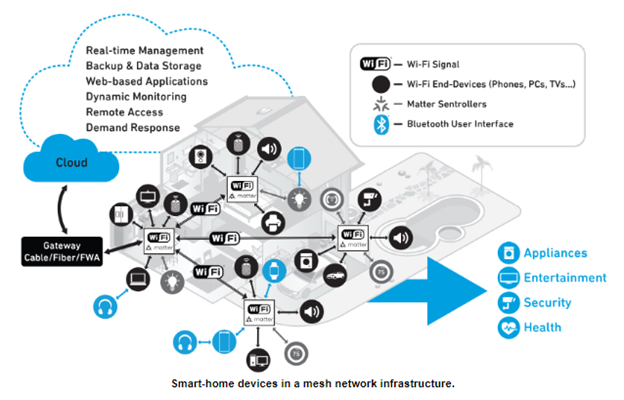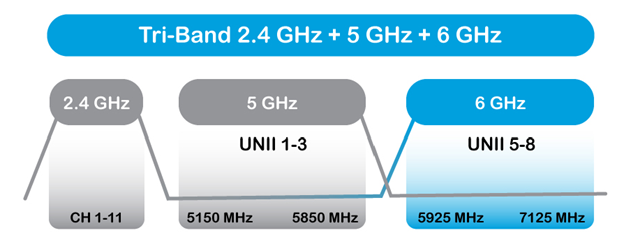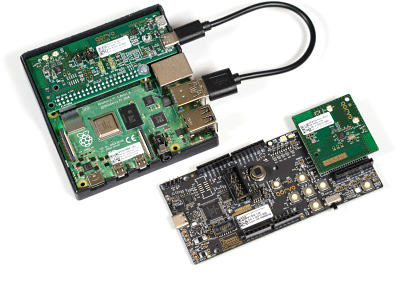The smart home market has finally started to gain traction. As manufacturers continue to roll out innovative technology solutions and consumers lean into the conveniences of the connected home, experts anticipate momentum to build over the next few years.
According to Statistica, worldwide revenue in the smart home market is expected to show an annual growth rate of 13.3% from 2022-2026, reaching a projected market volume of $ 207.8 billion by 2026. Forecasts from IDC look just as promising: Shipments of smart home devices are forecast to grow from 895.7 million in 2021 to more than 1.4 billion in 2026.
From a big-picture perspective, this is good news for both legacy players and newcomers in the smart device and IoT spaces. However, to be successful in any emerging market, developers need to have a deeper understanding of where the market is today, as well as the technology hurdles and trends that are shaping the market of tomorrow.
This article will unpack some of the major technology trends driving the smart home market, the top six challenges IoT and smart device engineers will have to overcome as the market shifts, and how Qorvo solutions will help prepare today's devices for tomorrow's market.
Emerging Tech Trends Shaping the Smart Home
There are several factors propelling the smart home market forward. Although rising consumer interest in home automation is playing a significant role, three major technology shifts are setting the stage for substantial market growth.
Matter
The first shift is the development of Matter—the industry's first universal or unifying smart home connectivity standard. Historically, lack of interoperability within the home network has been one of the industry's largest hurdles to overcome. Most of today's homes are equipped with a variety of IoT devices and hubs that are only able to support one or two wireless connectivity standards. This has created a literal disconnect between devices in the smart home ecosystem—a major setback for homeowners who want to create a fully connected smart home and for IoT manufacturers trying to create viable products regardless of eco system compatibility.
Matter, however, resolves the issue of walled gardens. Essentially, any smart home product carrying the Matter logo will be compatible with other Matter products, eliminating compatibility issues and allowing users to seamlessly connect new smart devices to their existing home networks. Manufacturers will also benefit from Matter's IP-based, open-source approach, which will simplify development and allow engineers to spend more time on innovation.
The Mesh Network
The second shift has been the growing use of mesh networks. This newer topology has been an important advancement in the evolution of Wi-Fi, particularly in the smart home, as it allows users to create a more connected home with more reliable communications.

Wi-Fi mesh systems include a router that connects to the main Internet connection and multiple satellite router-like devices (or nodes) placed around the home to provide full Wi-Fi home IoT coverage. Qorvo refers to this as “one pod per room.” This layout provides full redundancy and helps maximize network performance. Put simply—the more nodes, the farther the communication spreads.
Mesh networks or “one pod per room” layouts effectively extend signal range in the entire home, which increases reliability and enables real-time communication with all devices. In addition, advancements in Wi-Fi deployments allow for separating spectrum and ensure dedicated backhaul data paths for information to and from the cloud. Mesh networks self-configure and self-heal: They automatically incorporate a new node into the existing network without requiring adjustment by the network administrator, and they find the fastest and most reliable signal to transmit data, even when a node is blocked or loses signal.
Tri-Band Wi-Fi
The last shift has been the growing use of tri-band Wi-Fi. The technology, often used in mesh networks, vastly improves data capacity and coverage using 2.4 GHz, 5 GHz, and 6 GHz bands.

Tri-band technology offers several advantages over dual-band. First, users can connect more wireless devices to the Internet using the faster 5 GHz band or with Wi-Fi 6E, the 5 and 6 GHz band. Also, in mesh systems with multiple routers scattered throughout the home, the higher band acts as a dedicated communication line between two routers on the network, which can speed up the entire system by as much as 180 percent over older dual-band configured systems.
Technology Challenges and Solutions
While these three technology advancements are spurring market growth and opening up exciting opportunities for companies in the IoT and smart home spaces, they are also ushering in a whole new set of challenges for developers and engineers.
Below are the top six obstacles smart home network and device manufacturers will face as the market adopts these new technologies, as well as some of the solutions offered by Qorvo.
Challenge 1: Interoperability
The proliferation of IoT devices and communication protocols in a smart home network has created a difficult challenge for engineers and network architects. Keeping network activities coordinated between many standards while minimizing latency has become more complex.
Although many IoT devices in the smart home include support for multiple protocols, most rely on time division multiplexing (TDM) for communication. Time division multiplexing is a communications process that transmits two or more streaming digital signals over a common channel. This works well for a minimum number of devices, but in more complex home networks, the inherent latency and potential for dropped communications create problems. When multiple devices are competing simultaneously for a slice of communication time, network activity can be disrupted.
There are several ways companies can address this challenge. As described earlier, having one universal home connectivity standard (i.e., Matter) will help resolve some of the communication problems between devices and reduce complexity in mesh networks. However, as the industry transitions to Matter, multi-standard radios will be needed. These radios will future-proof the network to support migration to Matter and provide backward compatibility to connect nodes that use legacy standards.
Qorvo Solution: The QPG6100 software development kit (SDK), featuring Qorvo's ConcurrentConnect technology, employs a unique approach to ensure reliable communication and interoperability. While other multi-protocol market solutions are limited to communicating with only a single supported protocol at a time, Qorvo's ConcurrentConnect technology manages data traffic across all protocols with the technology capabilities integrated right into silicon. This allows for fluid, continuous communication across IoT devices, regardless of the protocols in use, and enables backwards compatibility. For example, an appliance running on a Matter network, a ZigBee-powered voice assistant, or a Bluetooth node can be controlled without sacrificing responsiveness.
The QPG6100 series SDKs includes three development boards for integrating Qorvo's controller into projects featuring peripherals, LEDs, buttons, and power supplies. A programming and debugging interface is part of the kit as well. A reference application provides a starting point for building a concurrent ZigBee router and Bluetooth Mesh smart light application. Several other sample applications are included for controlling many different smart home devices.
Challenge 2: RF Interference
With each generation of wireless technology, radio-frequency (RF) complexity in smart-home networks has increased. Many home RF communication devices use standards with overlapping or closely aligned frequency bands. Sometimes the bands are so close to each other, they cause one communication band to interfere with the transmitting and receiving signals from the other.
IoT and 5G add yet another level of complexity, which only intensifies the challenges for design engineers. Today's smart-home IoT devices must support many RF paths, with sometimes larger bandwidths, and maintain low power consumption—all without interference between standards and the data they are transmitting or receiving. With so many standards operating on one network, mitigating interference is imperative.
Fortunately, advancements to RF filter technology have greatly decreased the potential for different protocol standards to interfere with each other. Complex multi-filter modules such as bulk acoustic wave (BAW) are being used to address coexistence, capacity, and range in RF systems. Additionally, smaller filter form factors are helping IoT product manufacturers squeeze increasingly complex RF front end (RFFE) architectures into tiny devices.
Qorvo Solution: To meet the need of true mesh tri-band application, a well-designed filter is required. Qorvo has three BAW filter variants that boost overall Wi-Fi performance, maximize network capacity, increase RF range, and mitigate interference between the many different in-home radios operating simultaneously. Each filter is designed to solve different problems for different types of use cases, and with different benefits.
- Qorvo's coexBoost filters can be added to the transmit or receive chain of a radio to allow simultaneous use of additional radios using a different connectivity technology.
- Qorvo's edgeBoost filters can be added to the transmit chain of a radio to get better performance, particularly in the range of the channels that are close to the edge of the band.
- Qorvo's bandBoost filters are band isolation filters that enable simultaneous multi-band operation of a specific radio type (e.g., Wi-Fi) to multiply the capacity and throughput of the network for each split.
Challenge 3: Maintaining a Seamless and Reliable Connection
As previously discussed, the majority of today’s home networks include a collection of devices that use several different standards and technologies. These devices essentially have to switch back and forth between standards, communicating with one standard at a time, which causes a lag and triggers dropped communications.
Qorvo’s ConcurrentConnect technology helps resolve this issue by using a technology called concurrent listening, which continuously receives and translates communications. This allows protocol switching in a faster, more reliable way to reduce data packet losses, while still maintaining dynamic multi-protocol support.
IoT solutions with built-in antenna diversity can also help achieve a more seamless and reliable connection. This maximizes a device’s reliable range by ensuring the optimum antenna is always used, which minimizes the effects of multipath interference and maintains a quality connection.
Qorvo Solution: In addition to ConcurrentConnect technology, Qorvo’s QPG6100 series solutions and QPG7015M controllers include a patented antenna diversity and isolation scheme. This integrated feature leverages dual antennas to double the reliable range and offers additional robustness in a crowded wireless 2.4 GHz environment. This also reduces retransmissions, which improves battery life and minimizes latency issues.
Challenge 4: Creating an Ease-of-Use IoT Network
One of the smart home industry’s ongoing challenges has been creating a plug-and-play scenario for homeowners. The ultimate goal is for users to buy a smart home product, bring it home, and instantly add it to their network by simply opening up an app on their phone. However, with so many different technologies, standards, and user networks in place, this feature has been difficult for product manufacturers to achieve.
With the launch of Matter, the plug-and-play home network may finally become a reality. As a growing number of manufacturers adopt the universal standard, the majority of new IoT products, smart devices, and hubs entering the market will be compatible. As the industry transitions, however, IoT and smart device manufacturers will need to equip their products to be backwards compatible to ensure market viability.
Mesh networking will also help users and manufacturers achieve an easy-to-use, low-maintenance IoT network. A mesh network that uses a self-healing algorithm can automatically choose the best route to send data in the event that some nodes have inadvertently lost their connection. In other words, the algorithm ensures that traffic is routed only through available and functioning connections, which keeps the network in continuous operation. Mesh networking also enables devices to communicate directly with each other instead of having to route all communication via the gateway.
Tri-band technology is another way the industry is creating a better user experience due to its faster upload and download capabilities, especially when it comes to Wi-Fi video streaming applications. However, the use of higher frequency bands comes at a price of signal attenuation and higher probability of interference with other closely aligned spectrum. This requires designs to have a reliable filter solution. However, few filter suppliers can meet standard specifications of rejection, insertion loss, and power handling in the 5.2 GHz band, creating a whole new set of challenges for developers.
Qorvo Solutions: Qorvo offers several ways developers can overcome usability challenges. First, Qorvo’s communication controller chips are designed to be future-proof and support several different communication protocols, including Matter, ZigBee, Thread, and Bluetooth® Low Energy technology. The chips also feature a lifetime battery and maintenance-free sensors, as well ConcurrentConnect technology, which enables a single radio to deliver seamless operation between different protocols simultaneously without performance loss. This will help engineers create a viable, plug-and-play product that is also backwards compatible.
To address the common obstacles associated with tri-band technology, Qorvo provides three filter solutions for the UNII 5 GHz bands: the QPQ1903, QPQ1904, and QPQ2001 devices. All three solutions are based on Qorvo’s BAW filter design and technology capabilities, which ensures isolation between the ever-growing number of frequency bands and offers low insertion loss to support device performance requirements. Qorvo’s filters not only meet the required critical regulatory specifications, in most cases, they have done so with additional margin, and in the higher temperature ranges of up to 95⁰C—further helping customers and system designers meet stringent final product thermal management requirements.
Challenge 5: Network Security and Privacy
Implementing adequate security and privacy measures can be a significant challenge in IoT deployment. Today’s IoT networks are generally fragmented, using a variety of protocols and technologies, which makes security and privacy difficult to control.
This reality is a strong argument for standardization within the smart home market. In fact, this is a huge benefit of the industry transitioning over to Matter. Security was a key element of the standard’s design, and its architecture is based on best practices such as “secure by design” and “zero trust.” Every Matter device has a unique identity, and every device joining the network is authenticated to ensure it is a legitimate Matter-certified device. This allows applications and network administrators to block non-authorized or non-certified devices, offering another layer of protection.
Mesh networks also improve security and privacy by putting control and security power in the palm of the owner’s hands. Typically, these mesh systems are set up, controlled, and monitored using an app. The app helps with network setup and ensures that a secure password is set. The app can also enable the user to manage network issues, check data speeds, set of parental controls, and more. Mesh networks also typically perform automatic security updates, and many offer subscription-based security features that can offer enhanced protection from threats from malware, viruses, hackers, and cybercriminals.
Qorvo Solution: From a product development standpoint, security and privacy features can no longer be an afterthought. Instead, they need to be considered at the forefront of the design process and addressed throughout the entire development cycle. Choosing products like Qorvo’s QPG6100 series solutions and QPG7015M, which support security-forward technologies like Matter and mesh networks, can help companies bake enhanced into their IoT and smart device solutions.
Challenge 6: Power Consumption
The push for manufacturers to reduce power consumption and to develop greener products continues to intensify. While smart devices can help homeowners reduce their energy use, manufacturers and suppliers in the IoT industry are still feeling the pressure to create products that reduce their carbon footprint.
Many IoT products use coin-size batteries that can last up to ten years, but producing these batteries consumes fossil fuels. Moreover, smart device and IoT products that don’t use batteries, still use power from the grid. On top of that, most smart home networks include devices that continuously operate 24 hours a day, 7 days a week, which means they are consuming energy even when they aren’t being actively used.
With this in mind, efficiency and power consumption need to be a top design concern for IoT and smart device manufacturers and driving lower power consumption across the IoT network is a must. To keep power consumption requirements in check, features like efficient implementation of sleep modes are employed . Devices can further ensure efficient operation by including features that automatically notify users when batteries need replacement.
Qorvo Solution: Qorvo offers a host of ultra-low-power wireless data communication controller chips that enable smart home and IoT applications. The QPG6095J controller, for example, provides a fully integrated solution for ultra-low power wireless communications for Smart Home sentroller devices and specifically optimized for lighting applications.
In addition to performance features like multi-protocol support and ConcurrentConnect technology, the QPG6095J has advanced power management features to ensure that power consumption is minimized in active as well as in standby states, enabling maintenance-free and very small form factor products. For lower power consumption, the integrated DC/DC Buck converter can be used together with a few external components. Alternatively, the internal regulator can be used instead of the integrated DC/DC converter, to minimize the bill of material.
Preparing for What’s Next
For the first time, a future that includes a fully automated home is within reach. After years of fragmentation, the smart home industry is advancing and gearing up for substantial growth. Key developments like Matter, the mesh network, and tri-band Wi-Fi technology are helping to push the market forward, and IoT leaders are innovating and developing new products with this highly connected environment in mind.
As with any emerging market, new advancements will usher in a whole new set of design considerations for product developers and engineers. However, with the right technology solutions and design strategies in place, IoT and smart device manufacturers can create products that will not only be successful in today’s market, but will continue to thrive in the smart home of tomorrow.
